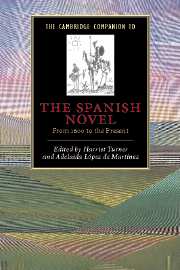Book contents
- Frontmatter
- 1 On the novel: mirror and text
- Part 1 Since Cervantes
- Part 2 The nineteenth century
- Part 3 The twentieth century
- 10 From the Generation of 1898 to the vanguard
- 11 The testimonial novel and the novel of memory
- 12 Questioning the text
- 13 Women and fiction in post-Franco Spain
- 14 Cultural alliances: film and literature in the socialist period, 1982–1995
- 15 The novel beyond modernity
- 16 Writing about writing
- Bibliography
- Index
- Series List
14 - Cultural alliances: film and literature in the socialist period, 1982–1995
from Part 3 - The twentieth century
Published online by Cambridge University Press: 28 May 2006
- Frontmatter
- 1 On the novel: mirror and text
- Part 1 Since Cervantes
- Part 2 The nineteenth century
- Part 3 The twentieth century
- 10 From the Generation of 1898 to the vanguard
- 11 The testimonial novel and the novel of memory
- 12 Questioning the text
- 13 Women and fiction in post-Franco Spain
- 14 Cultural alliances: film and literature in the socialist period, 1982–1995
- 15 The novel beyond modernity
- 16 Writing about writing
- Bibliography
- Index
- Series List
Summary
Literature and film have established an interdependent relationship since the beginning of the film industry at the turn of the twentieth century. From the first silent films, which the brothers Lumière and Georges Méliès made and which followed theatre's spatial laws and dramatic structure, to the innovations introduced by David Griffith, which turned cinema into a narrative language structured according to the models of the nineteenth-century novel, cinema invariably appears as a mechanical form of reproducing a story.
Cinema flirted with poetry for a short, intense period of time. The artistic avant-garde discovered film’s potential to break with the old order and “dehumanize art,” as well as its power to express political ideologies. Cinema could summon and mobilize an essentially popular audience through a new medium of mass communication. Cinema also articulated in images the ruptures produced in aesthetics or ideology in the first third of the century, and while continuing to be linked intrinsically to literature, it emerged, as Peña-Ardid writes, as a necessary life raft if one were to “abandon rancid realism.” Thus cinema became a powerful instrument “for expressing the imaginary, the unreal, or the dreamed.”
- Type
- Chapter
- Information
- The Cambridge Companion to the Spanish NovelFrom 1600 to the Present, pp. 231 - 250Publisher: Cambridge University PressPrint publication year: 2003



